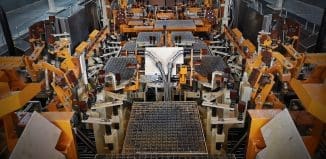Command and Control room’s importance in today’s Safe City
 As much as modern control rooms are based on technology, it’s still humans who operate them. Optimal human functioning is key to control room efficiency and security, whether for air traffic control, military and civil command & control centers, or network operations centers (NOCs). Tri-Tech explains the importance of such tailor-made work stations for the new municipal command and control center in today’s Safe City.
As much as modern control rooms are based on technology, it’s still humans who operate them. Optimal human functioning is key to control room efficiency and security, whether for air traffic control, military and civil command & control centers, or network operations centers (NOCs). Tri-Tech explains the importance of such tailor-made work stations for the new municipal command and control center in today’s Safe City.
The Israeli company Tritech Infrastructures, a business partner of APC by Schneider Electrics, specializes in the design and integration of physical infrastructure for technology-intensive facilities such as data centers, command & control rooms and est. In today’s safe city hectic environment, the city’s decision makers are required to take decisions and communicate those forces at field as fast as possible. Moreover, the rapid technological evolution over the past decades has seen command & control rooms become ever more sophisticated, combining information channels ranging from video and voice communications (radio, phone) to computerized systems (SCADA, radar, BMS, etc.). While the ability for comprehensive real-time monitoring never ceases improving, the proliferation of data and channels creates intense work environments. Operators must maintain high level concentration to process information, isolate critical events, take decisions and communicate them to the relevant receivers as fast as possible. The municipality of Rishon le-Zion in Israel, a 250,501 inhabitant city, had realized the need and its command and control center which was designed by Tri-Tech is enabling it to control the safe city network.
 The command and control room at Rishon le Zion is connected to the city’s 1000 surveillance cameras and serves as a call center for residents’ inquiries, complaints and distress calls. The center receives on average 1800 to 2000 calls a day; the operators delegate cases to the relevant municipal agencies and follow up until the case is closed. And, in emergency situations, the center must assume crisis management as well.
The command and control room at Rishon le Zion is connected to the city’s 1000 surveillance cameras and serves as a call center for residents’ inquiries, complaints and distress calls. The center receives on average 1800 to 2000 calls a day; the operators delegate cases to the relevant municipal agencies and follow up until the case is closed. And, in emergency situations, the center must assume crisis management as well.
This diversity of functions and tasks translates into a very busy environment where operators handle multiple information and communication channels such as video, phone calls, e-mails, radio and text messages. In addition, direct contact with municipal residents demands consistent friendliness and patience.
Understanding the intensity of operators’ work days (and nights), the planning committee of Rishon le Zion project strongly emphasized the need for an esthetic, ergonomic and user-friendly space with optimal work conditions.
 According to Baruch Kaver, CTO and Partner at Tritech Infrastructures: “In many cases control room design focuses primarily on integrating technical systems while neglecting the human factor. A human-centered design is of equal importance.” He adds: “Therefore in the design of the room the focus must lie on the optimal allocation of work spaces in relation to multi-media walls, windows and other peculiarities of the room.”
According to Baruch Kaver, CTO and Partner at Tritech Infrastructures: “In many cases control room design focuses primarily on integrating technical systems while neglecting the human factor. A human-centered design is of equal importance.” He adds: “Therefore in the design of the room the focus must lie on the optimal allocation of work spaces in relation to multi-media walls, windows and other peculiarities of the room.”
Tritech worked closely with the planning committee to design work stations that provided each operator with a personal space that promotes the ability to work as undisturbed as possible while supporting comfortable access to all sources of information. The idea was to give generous width and depth of the desk, with plenty of leg space as well as sufficient distance between the operators and the screens. With each console accommodating two operators, a black triangle was inserted into the desk surface to optically mark each operator’s own space.
The systems were then arranged around this setting. The company notes that the Zigzag positioning which is illustrated in the design of Rishon le Zion’s control room enables communication among the operators while providing a comfortable angle to the screen.
“The municipal control center is a busy environment, dealing with a huge amount of information and calls for action. We wanted to create for each operator a physical space in which he or she can analyze the situation and plan the next step in as comfortable a way as possible. This is expressed in spacious and user-friendly work stations, elegant and light design and smart arrangement of the multi-media systems, lighting and noise-reducing elements. Since we moved into the new control room, we can see how the ergonomic environment helps operators to not only act quickly, but remain calm during critical situations and interact well with external agencies.”
According to Eytan Eli, B.Sc., Saifor Consoles product manager at Tritech: “Designing the individual work stations is taking into consideration the need to create an optimal visual and hearing experience where information can be absorbed in the most effective, comfortable way”, He adds: “Cognitive ergonomics are essential, Consoles that are tailor-made for the particular work processes contribute essentially to operator’s efficiency and prevent errors caused by fatigue.”






























